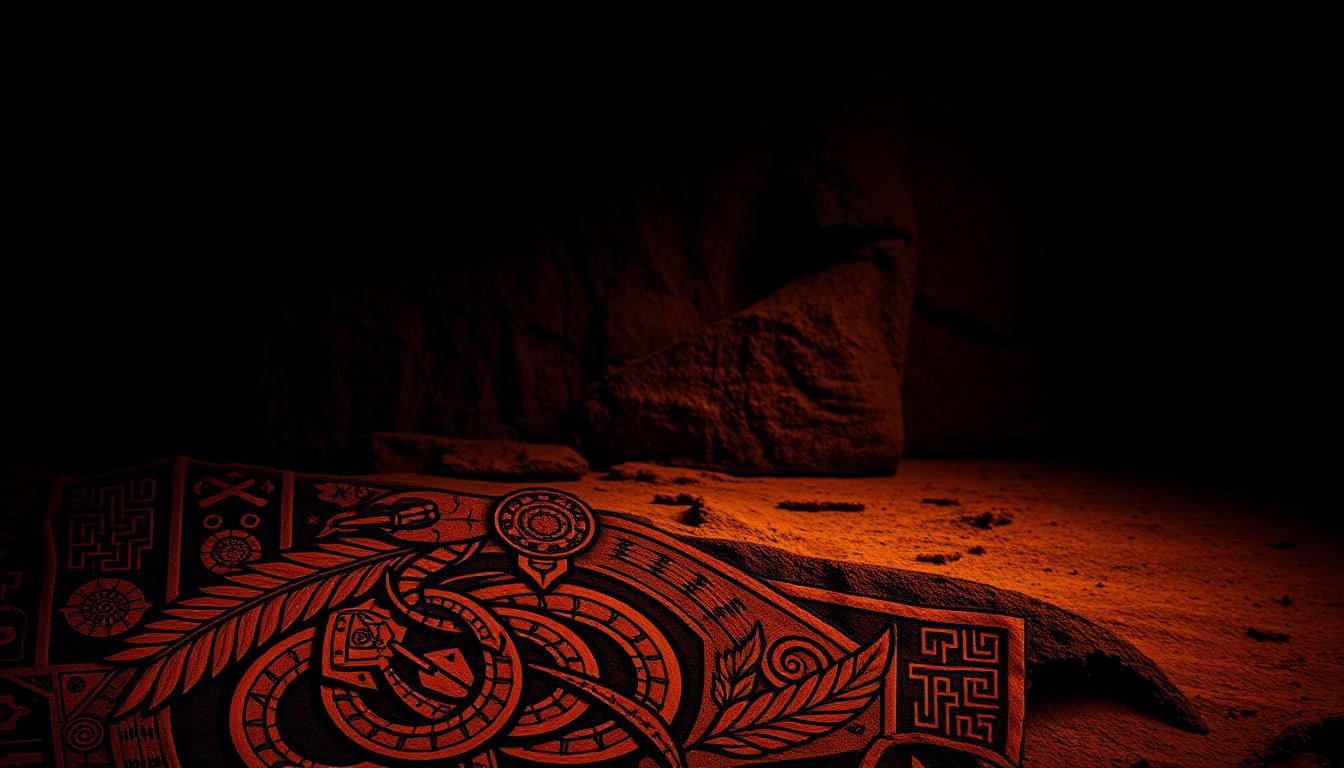
The Aztec civilization, which dominated Central America from the 14th to the 16th century, has left a lasting legacy in the world of tattooing. The symbols and deities of this ancient culture have inspired a unique and visually striking style of body art.
For modern enthusiasts, Aztec tattoos represent a connection to ancient wisdom, a way to honor indigenous heritage, or a means to express personal qualities associated with Aztec symbols. These tattoos are known for their intricate designs and deep symbolism, making them a popular choice for those seeking meaningful body art.
Key Takeaways
- Aztec tattoos draw inspiration from the ancient Mesoamerican civilization.
- These tattoos feature intricate designs with specific meanings.
- The history of Aztec tattooing is rooted in religious and social practices.
- Modern enthusiasts choose Aztec tattoos for their aesthetic and symbolic value.
- Understanding Aztec symbolism is key to choosing a meaningful design.
The Rich Heritage of Aztec Body Art
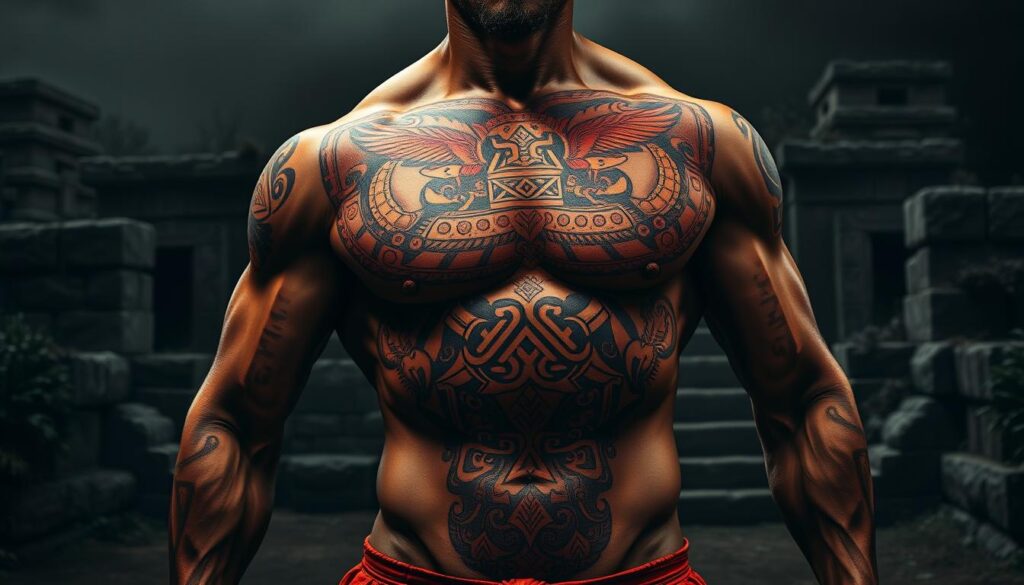
The heritage of Aztec body art is a complex tapestry woven with threads of religious beliefs, cultural practices, and historical events. The Aztec civilization, which thrived in central Mexico from the 14th to the 16th centuries, left an indelible mark on the world of body modification.
Historical Tattooing Practices in Mesoamerica
While the exact nature of Aztec body art is still debated among scholars, it is known that neighboring cultures such as the Maya, Otomi, and Huaxtec practiced permanent tattooing. Archaeological findings and Spanish colonial accounts suggest that the Aztecs may have also used tattoos during specific religious ceremonies.
| Culture | Practice | Significance |
|---|---|---|
| Maya, Otomi, Huaxtec | Permanent Tattooing | Cultural and Spiritual Identity |
| Aztecs | Body Paint and Possible Tattoos | Religious Ceremonies and Warfare |
Aztec Tattoos vs. Body Paint: Understanding the Distinction
There’s a significant difference between the permanent tattoos used by some Mesoamerican cultures and the temporary body paint used by Aztec warriors and priests. Understanding this distinction is crucial for appreciating the authentic cultural practices that inspire contemporary Aztec tattoo designs.
The Cultural Significance of Traditional Aztec Tattoos
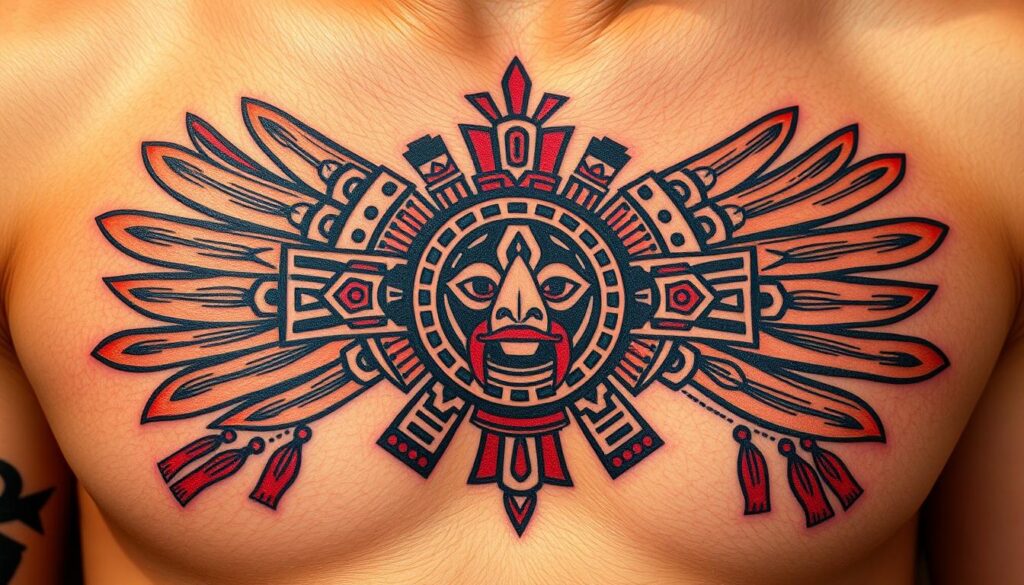
Aztec tattoos were more than just decorative art; they were deeply rooted in the culture and beliefs of the Aztec people. These intricate designs played a crucial role in the spiritual and social lives of the Aztecs, serving as a visual representation of an individual’s status, spirituality, and cultural identity.
Religious and Ceremonial Importance
In Aztec culture, tattoos were often used in religious ceremonies to honor their gods and goddesses. The process of getting a tattoo was considered a sacred ritual, with specific designs dedicated to particular deities. For instance, a tattoo of the Aztec god Huitzilopochtli might be worn by a warrior as a symbol of strength and protection. These tattoos not only reflected the wearer’s devotion but also were believed to provide spiritual protection and enhance their personal power.
Warrior Status and Tribal Identity
For Aztec warriors, tattoos served as visible badges of honor, indicating their achievements in battle and their rank within the military hierarchy. The designs often depicted animals such as eagles and jaguars, which were revered for their strength and ferocity. Beyond individual status, these tattoos helped establish and reinforce tribal identity, allowing members to visually express their lineage and community affiliation. To learn more about the various tattoo designs and their meanings, you can visit https://nailcutandink.com/beautiful-tattoos/ for additional information.
| Tattoo Design | Symbolism |
|---|---|
| Eagle | Strength, Courage |
| Jaguar | Ferocity, Power |
| Serpent | Renewal, Transformation |
The significance of these tattoos extends beyond their aesthetic appeal, as they continue to influence contemporary tattoo designs and remain an important part of Aztec cultural heritage.
Popular Traditional Aztec Tattoo Designs
Traditional Aztec tattoos feature a wide range of designs, each with its own unique symbolism and cultural significance. These designs not only reflect the artistic prowess of the Aztecs but also convey deep meanings related to their religious beliefs, warrior culture, and connection with nature.
Aztec Eagle Tattoos: Symbol of Power and Courage
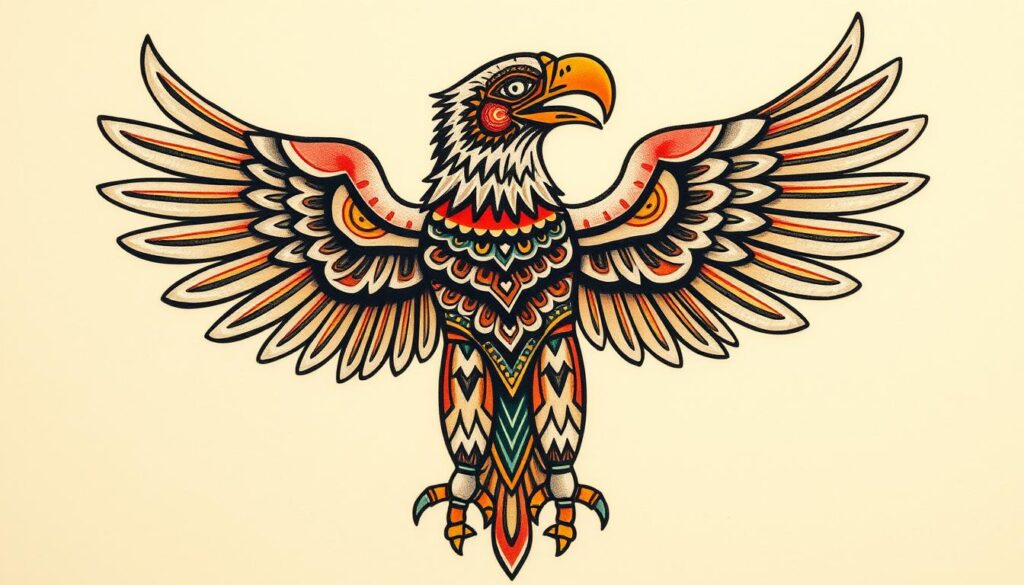
The Aztec eagle is a revered symbol in Aztec tattoo designs, representing power, courage, and strength. Authentic Aztec eagle designs typically feature the bird facing west with an open beak and prominent feathers, symbolizing a strong spiritual connection to the sun deity.
Sun and Calendar Stone Designs
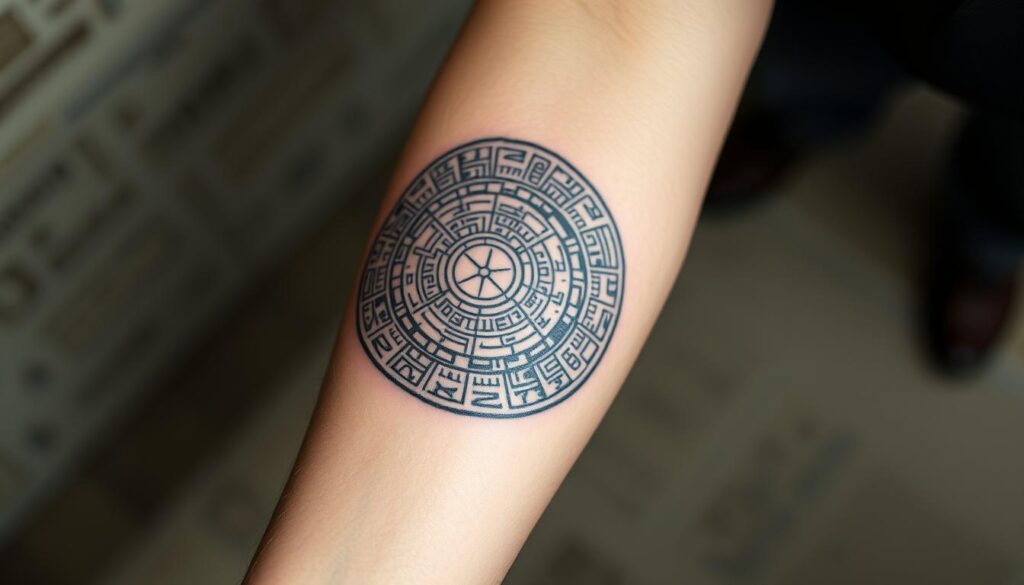
The Aztec Calendar Stone, also known as the Sun Stone, is a highly recognizable Aztec tattoo design. It represents the Aztecs’ intricate understanding of time and cosmic cycles. The design features concentric circles filled with symbols for the days and months of the Aztec year, making it a rich and complex tattoo choice.
Warrior and Deity Representations
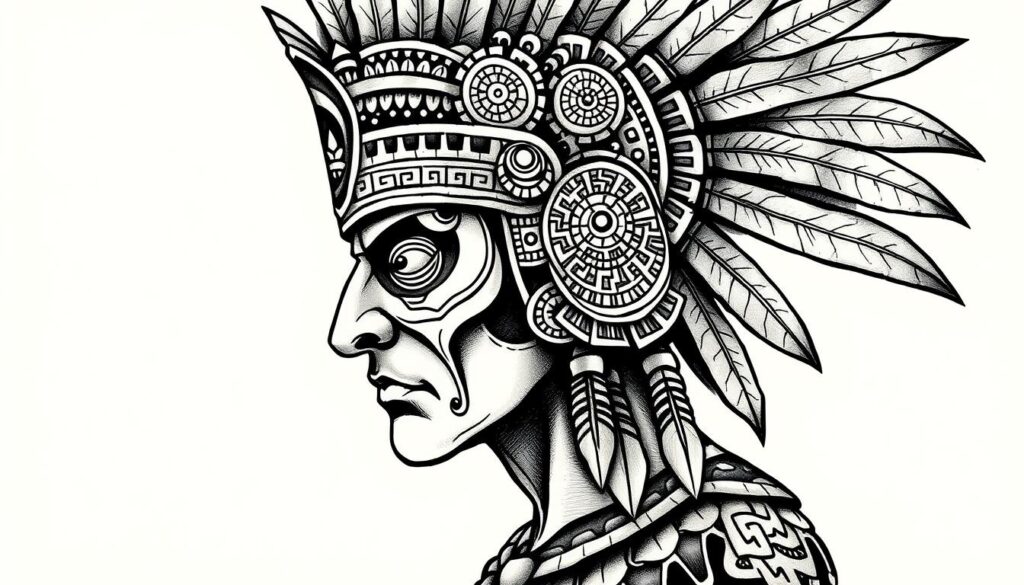
Warrior imagery is another popular category of Aztec tattoo designs. These tattoos often depict fierce fighters adorned with elaborate headdresses, weapons, and symbolic elements that convey bravery and martial prowess, reflecting the importance of warriors in Aztec society.
Animal Symbols: Jaguar, Serpent, and More
Beyond the eagle, other animal symbols play crucial roles in Aztec tattoo art. The jaguar represents stealth and night powers, while serpents symbolize wisdom and transformation. Each creature carries specific spiritual meanings, offering a wide range of symbolic choices for tattoo designs.
Geometric and Abstract Patterns
Geometric patterns and abstract designs drawn from Aztec architecture, pottery, and codices offer versatile tattoo options. These designs can be adapted to various body placements while maintaining authentic cultural connections, making them popular choices for those seeking unique Aztec-inspired tattoos.
Symbolism and Meanings Behind Aztec Tattoo Elements
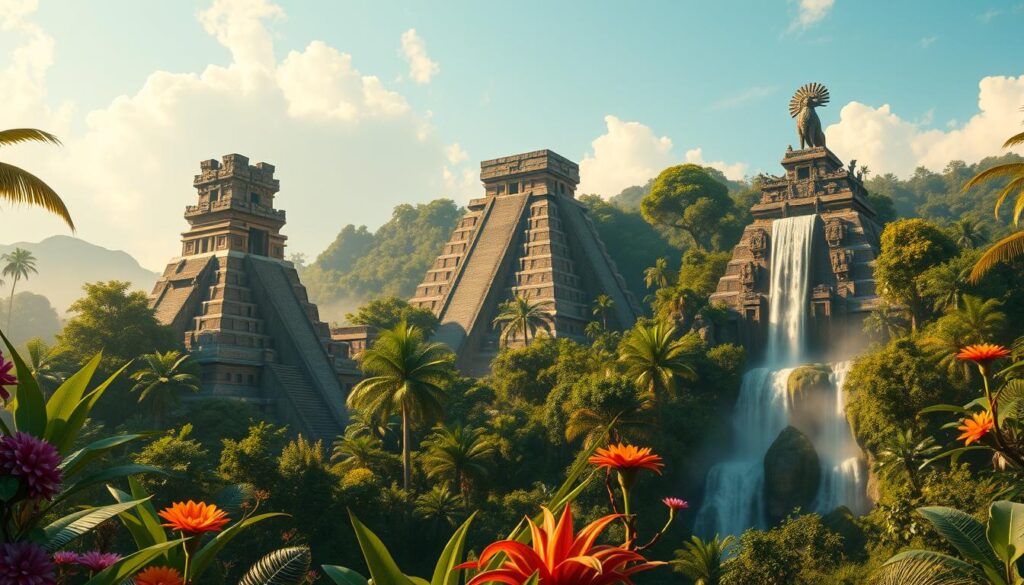
Aztec tattoos are rich in symbolism, drawing from a complex pantheon of gods and natural elements. These symbolic elements not only made the tattoos visually striking but also imbued them with deep cultural and spiritual significance.
Gods and Deities in Aztec Tattoo Art
The Aztec pantheon featured numerous gods and deities, each associated with specific natural forces, human activities, or cosmic principles. Two of the most significant deities in Aztec tattoo art are Quetzalcoatl and Huitzilopochtli.
Quetzalcoatl: The Feathered Serpent
Quetzalcoatl, the feathered serpent, symbolizes wisdom, creation, and the wind. A Quetzalcoatl tattoo can represent qualities such as wisdom, creativity, personal growth, and transformation.
Huitzilopochtli: God of War and Sun
Huitzilopochtli, the primary war god and sun deity, represented martial prowess and solar energy. Tattoos of this god often symbolize strength, leadership, and personal power.
Natural Elements and Their Significance
Natural elements like earth, water, wind, and fire held special significance in Aztec cosmology. Each element was connected to specific deities and directional powers, making them meaningful inclusions in tattoo designs.
Life, Death, and Rebirth Symbolism
The Aztecs believed in the cycle of life, death, and rebirth. Symbols like skulls and flowers represented the transient nature of existence and the promise of renewal after death. This cycle is reflected in the table below, highlighting key symbols and their meanings.
| Symbol | Meaning |
|---|---|
| Skulls | Represent death and the cycle of life |
| Flowers | Symbolize renewal and the beauty of life |
| Serpent | Represents transformation and renewal |
| Sun | Symbolizes life force and spiritual illumination |
Aztec Tattoo Placement and Traditional Techniques
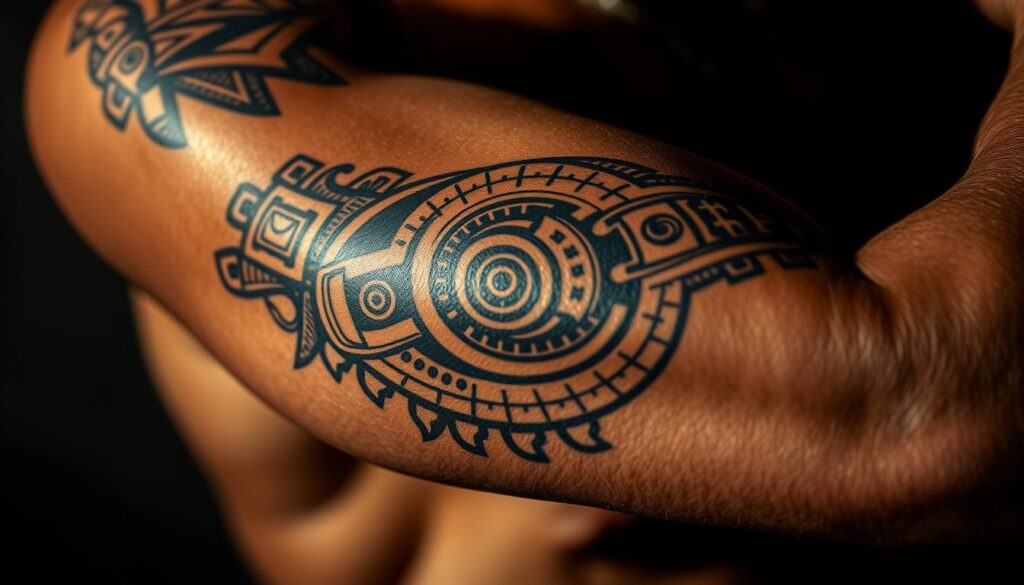
The significance of Aztec tattoos lies not only in their designs but also in their placement on the body and the methods used to create them. In Aztec culture, the placement of tattoos was crucial, as certain locations were believed to enhance the spiritual and protective qualities of the tattoo designs.
Power Centers of the Body
In traditional Aztec culture, specific parts of the body were considered power centers. The chest, wrist, and stomach were particularly valued as tattoo locations, believed to harness the body’s natural energy and strengthen the symbolic power of the designs placed there.
Ancient Techniques and Modern Adaptations
Today, while most Aztec tattoos are created using modern tattoo machines and inks, some artists seek to honor traditional techniques through hand-poked methods. Ancient Aztec tattooing involved puncturing the skin with sharp tools made from bone or obsidian and rubbing ink made from natural materials into the cuts.
This blend of old and new techniques allows for a unique part of Aztec culture to be preserved and appreciated today.
Choosing Your Own Aztec-Inspired Tattoo
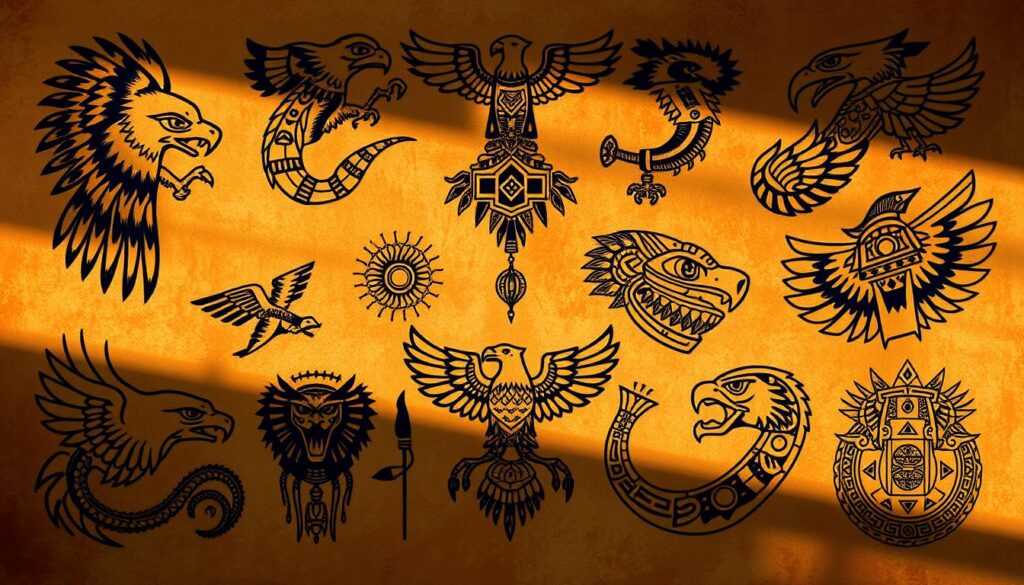
When it comes to selecting an Aztec-inspired tattoo, understanding the rich cultural heritage behind these designs is crucial. Aztec tattoos are not just visually striking; they carry deep symbolic meanings rooted in the history and mythology of the Aztec civilization.
Researching Authentic Designs
To choose an authentic Aztec tattoo design, one must research the historical and cultural context of Aztec symbols. This involves consulting reputable sources such as archaeological publications and museum collections to ensure accuracy and respect for the original meanings.
Personalizing Ancient Symbols
While authenticity is key, personalizing ancient Aztec symbols can make your tattoo more meaningful. This should be done thoughtfully, maintaining cultural respect and ensuring that the design represents your personality and values.
Finding the Right Tattoo Artist
Finding an artist experienced in Aztec tattoo designs is crucial. Review their portfolio for examples of Mesoamerican or indigenous artwork to ensure they can handle the intricate patterns and symbolic elements with precision.
By combining thorough research, thoughtful personalization, and the right artist, you can create a tattoo that is both a personal statement and a respectful tribute to Aztec cultural heritage.
Conclusion
For those drawn to the mystique of ancient civilizations, Aztec tattoos offer a powerful connection to a rich cultural heritage. These timeless designs embody strength, courage, and spirituality, making them a popular choice among tattoo enthusiasts.
Popular designs like the Aztec eagle tattoo and Aztec warrior tattoo symbolize bravery and determination, while the Aztec sun tattoo represents life-giving energy and spiritual illumination. By choosing an Aztec-inspired tattoo, individuals not only express personal attributes but also participate in preserving a cultural legacy.
It’s essential to approach Aztec tattoos with respect and knowledge, understanding the significance behind each symbol. Whether drawn to their aesthetic appeal or deeper meanings, these tattoos continue to captivate people worldwide, serving as a testament to the enduring power of Aztec culture.
